
MONORAILS



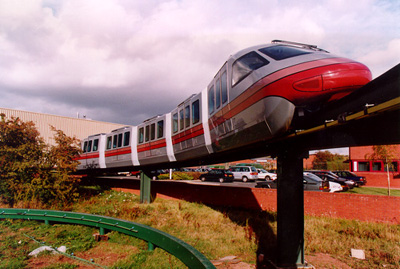
Imagine getting in your car in the morning and falling asleep on
your way to work. Unless you have a chauffeur, this is bound to be very
bad news. But in the world of a not too distant future this could be
an everyday occurrence. The car of the future will drive on a
monorail. You wouldn’t have to steer it, it would be on a track - a
track embedded with sensors to know where your car is at any moment. In
this car, you walk in, have a seat and type in your destination on
a keyboard. The onboard computer would then do all the rest - steer, speed
up, slow down, and get you to your destination on the most efficient route
available. This leaves you free to relax, enjoy the sights, sit back and
watch a movie or the morning news, work from a computer, make phone calls,
or even sleep! You could even drink and drive without worry or have a meal
with a friend. A table could pop up in the middle of your "cabin" space for
a sit down dinner. Freeing your eyes, hands, legs, and mind from the control
of the vehicle, you could get creative as to how you spend your traveling
time. This will revolutionize the world of commuting. The stress and
strain of driving, traffic, and other hazards of the road will be a relic
of the past.

This technology is available today even though there is so little
support, in terms of research and finance, to bring this superior mode
of travel into being, particularly here in the USA. Many countries have
begun to see the benefits of having a monorail system and are expanding
both research and installation. There are working monorails in Japan,
Sweden, Australia, Germany, Canada, Korea, Denmark, Indonesia and a
number of other countries. This is time-tested technology that is
continually ignored and its benefits downplayed. In large part, this is
due primarily to the competitive warfare of the auto industry, and their
powerful lobbying interests in political policy-making. "The first large
scale urban streetcar abandonments were orchestrated by General Motors in
1925. GM went on to bankroll National City Lines (buses), which began
buying up streetcar companies, and, with Standard Oil of California
(Chevron), Phillips Petroleum, Firestone Tire and Mack Truck, tore out
the tracks in eighty-five American cities." (*1)
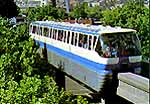 It may be many years before monorails succeed in replacing the
environmentally degrading system of cars and roads now in operation.
This new system will radically alter our everyday world to a large
degree. There would no longer be a use for gas stations, auto repair
and body shops, tow trucks, road service, traffic control, car
insurance, DMV, and a host of other car-related products and services.
(I'm not so sure I myself would miss these very much.) This would
certainly change the economy from its present state and there are many
sectors of the workforce which would be affected, some being eliminated
entirely. This, of course, also scares a lot of people about the
benefits of the monorail system. On the other hand, there has only been
one recorded instance of death on a monorail in this century, making it,
hands down, the safest method of travel of all modern power-driven
systems.
It may be many years before monorails succeed in replacing the
environmentally degrading system of cars and roads now in operation.
This new system will radically alter our everyday world to a large
degree. There would no longer be a use for gas stations, auto repair
and body shops, tow trucks, road service, traffic control, car
insurance, DMV, and a host of other car-related products and services.
(I'm not so sure I myself would miss these very much.) This would
certainly change the economy from its present state and there are many
sectors of the workforce which would be affected, some being eliminated
entirely. This, of course, also scares a lot of people about the
benefits of the monorail system. On the other hand, there has only been
one recorded instance of death on a monorail in this century, making it,
hands down, the safest method of travel of all modern power-driven
systems.
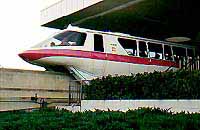
Taking the responsibility out of the hands of the individual driver,
a computer-controlled track and car would have no "accidents". There
would be no drunk driving, or sliding on ice or rain-slicked roads. You
couldn’t fall asleep at the wheel; there would be no more vehicle-related
injuries and deaths. There would be no roads on the ground so there’s
nothing to collide with, no intersections. This would eliminate the
need for traffic police and free up these resources for the prevention of
real crimes, thereby directly enhancing our quality of life. No longer would
we be faced with suspended licenses, or jail sentences for driving and
insurance related offenses. The world could breathe a lot easier without
all that carbon monoxide and fumes everywhere. You can't run out of gas
and you'll never get a flat tire. Traffic jams will be a thing of the
past. It seems to me that insurance companies and lawyers would stand
to lose a lot of revenue from such a fail-safe transport system such as
the monorail. This kind of service provision would surely be severely
scaled back but perhaps this isn't such a bad thing for most of us. Each
year, more than 500,000 people die in road accidents. 70 percent of these
deaths are in first-world countries. Two-thirds of these deaths involve
pedestrians, of which one-third are children (nearly 80,000).
(*2)
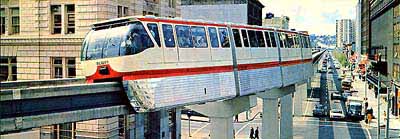

The monorail is capable of actually being a profitable venture as
opposed to the cost of operation and maintenance of any other rail
system. The monorail in Seattle, WA was built in 1962 and is in
operation to this day, run by a private corporation which pays the city
of Seattle $75,000 a year to operate it. The monorail line from Tokyo
to Haneda in Japan is privately owned and has been a money-making
venture since it first started in 1964. Each day, the US spends about
$200 million to build and rebuild its roads. Over $13 billion is spent
each year to maintain its roads and highways yet it is estimated to
cost over $26 billion a year to maintain them in their present
condition. The roads are deteriorating and at the same time our usage is
increasing. In 15 years congestion will be three times as bad, even if
the amount of roads increase by 20 percent.
Together with the technology of magnetically levitated (maglev) cars,
this method of travel is extremely quiet and capable of high speeds,
perhaps even as fast as 350 miles per hour (*3).
Another system being studied at this time is the pneumatic propulsion
system. This is done with air pressure pumped through the track which
pushes against a pressure plate on the bottom of the car. Both of these
operate very quietly and require no motor within the car. There are
absolutely no moving parts, no gears, no attachments of any kind. The
maglev trains hover between 6 to 8 inches above the track. Friction is
reduced to zero which eliminates any possibility of bumps, rattles,
squeaks, and shakes. Riding on the maglev train is a quiet, smooth,
comfortable ride. In addition, the lack of friction greatly enhances
performance, needing much less energy to move the car than it would on
a conventional road. There is also a way to get back the energy used for
braking the vehicle and reuse it to accelerate.

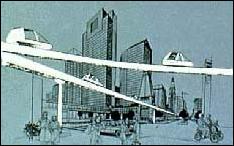
It may be a long time before we can implement this wondrous mode of
travel but at some point in the future there will be no more roads
cutting up the precious land nature provides us with. The countless
criss-crossed roads of our present transportation infrastructure, which
have destroyed the natural habitats of many of nature's plants and
animals, will no longer be necessary. This fragmentation process has
severely curtailed our biodiversity in the last half of the 20th
century. In elevating our powered transportation off the Earth, animals
will be free to roam without the threat of being run over or fenced out
of land areas. Delicate fauna may flourish with the connecting up of
larger tracts of land. We might be able to stem the tide of alarming
rates of disappearance of Earth's more fragile species. "Approximately
one million animals per day are killed on U.S. roads. Cars are the
leading cause of death of endangered species such as the mountain lion
in Southern California." (*4)

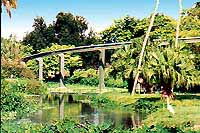 In the place of roads will be park-like corridors of planted grass,
shrubs, and a more natural setting. We will replace our heavy footprint
upon the land with a more lightly treading signature. The monorail is
supported by poles in the ground, located anywhere from 20 to 50 feet
apart. Taking up no more space on the ground than the trunk of a
medium-sized tree, it is largely unobtrusive and with advanced
materials can be maintenance free for 100 years. Eventually all roads
could be replaced by poles in the ground and elevated rails for our
safe transportation from door to door. Instead of a garage, the
attachment to your home could be a room where the monorail comes
through. Your car would be ready and waiting outside a door on the
second floor.
In the place of roads will be park-like corridors of planted grass,
shrubs, and a more natural setting. We will replace our heavy footprint
upon the land with a more lightly treading signature. The monorail is
supported by poles in the ground, located anywhere from 20 to 50 feet
apart. Taking up no more space on the ground than the trunk of a
medium-sized tree, it is largely unobtrusive and with advanced
materials can be maintenance free for 100 years. Eventually all roads
could be replaced by poles in the ground and elevated rails for our
safe transportation from door to door. Instead of a garage, the
attachment to your home could be a room where the monorail comes
through. Your car would be ready and waiting outside a door on the
second floor.
Monorail cars, due to their simplicity, are maintenance-free.
There are no tires, shock absorbers, spark plugs, fuel pumps, gas tanks,
tailpipes, radiators, drive shafts, transmissions,
and a vast array of machined parts; no motor to break down. No moving
parts whatsoever.
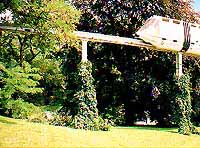 There is much less baggage to carry around in terms of gross vehicle weight.
This makes the monorail car easier to move, consume less energy, and cost
less to operate than any automobile.
There is much less baggage to carry around in terms of gross vehicle weight.
This makes the monorail car easier to move, consume less energy, and cost
less to operate than any automobile.
If the cars are kept to a small minimum of people per car, they can
be built lightweight and make construction of the infrastructure even
simpler in design. In this system, cars kept to a 600 pound maximum can
have a track built at less than $1 million per mile, compared to
today’s present cost of $24 million per mile for a typical highway. In
a more conventional monorail system with cars weighing up to 100,000
pounds, the infrastructure necessary to sustain this kind of weight
would drive the price upwards of $40 million per mile.(*6)

There are as many ways to see how the monorail system may evolve as
there are kinds of travel available today. In addition to owning a
personal vehicle that may only seat one or two people, there could be
progressively larger models to accommodate more travelers or even having
larger space to move cargo. There is also the definite possibility of a
taxicab service - with no taxi drivers.
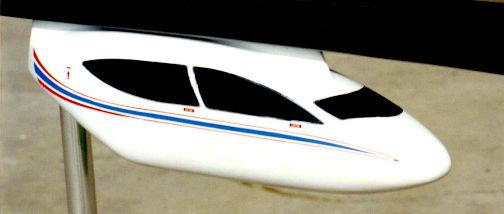 You could call on the phone and have a car delivered to your door,
charge the ride to your bank account, credit card or company account.
Lease by the week, the month or the year if you desire. Tour vehicles
could be programmed to take you specific places and have accompanying
audio and video to augment the tour. Have a lavish "home on the road",
with separate rooms or a streamlined one person pod. Connect a bunch of
them together in a chain for efficient travel on long distance rides
traveling at higher speeds. Open up a retail shop out of your traveling
store, having the ability to go to homes or to city centers where large
volumes of people shop, or to flea markets where rows and rows of
personal pod monorail vehicles are lined up like little shops.
You could call on the phone and have a car delivered to your door,
charge the ride to your bank account, credit card or company account.
Lease by the week, the month or the year if you desire. Tour vehicles
could be programmed to take you specific places and have accompanying
audio and video to augment the tour. Have a lavish "home on the road",
with separate rooms or a streamlined one person pod. Connect a bunch of
them together in a chain for efficient travel on long distance rides
traveling at higher speeds. Open up a retail shop out of your traveling
store, having the ability to go to homes or to city centers where large
volumes of people shop, or to flea markets where rows and rows of
personal pod monorail vehicles are lined up like little shops.
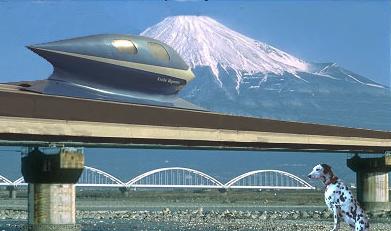 Perhaps commuting diners will be the rage in the coming century.
Instead of going out to your favorite restaurant, you could have it
come to you... or see the sights while you dine. A special track could
be set up for cars traveling at a leisurely pace; riding along the
ocean at sunset, or through the woods in the morning for breakfast.
Cars could be sent from one place to another without passengers as a
courier service. Order merchandise and have it arrive within the hour.
Order your groceries on the Internet and delivered on a monorail to
your home. The possibilities are staggering.
Perhaps commuting diners will be the rage in the coming century.
Instead of going out to your favorite restaurant, you could have it
come to you... or see the sights while you dine. A special track could
be set up for cars traveling at a leisurely pace; riding along the
ocean at sunset, or through the woods in the morning for breakfast.
Cars could be sent from one place to another without passengers as a
courier service. Order merchandise and have it arrive within the hour.
Order your groceries on the Internet and delivered on a monorail to
your home. The possibilities are staggering.

In January of '99, I had the opportunity to ride the monorail
recently opened in Jacksonville, Florida. The track presently runs from
one side of the city to the other, ringing it in a northerly direction
with a fork at one end headed east and the other more in a southerly
direction. The train is completely computer controlled, has no driver,
and runs on rubber tires with the motor in the train itself. Two cars
are coupled, each with a seating capacity of 6 to 8 with added room to
stand for perhaps as many as 10 or 12 more in each cab. Its maximum
speed I would gauge at 35 MPH, although it may actually be more or less.
The cost to ride was a mere 35 cents (compared to NYC's subway at
$1.50). Talking to a rider on the monorail who lived in Jacksonville,
he affirmed that the monorail gets a lot of use and is extremely handy
during the day to get from one side of the city to the other when the
streets can be gridlocked and take a substantially longer amount of
time to go by car. The view, is spectacular, especially at night
when all the buildings are lit up and the bridges are lined
in blue neon.


A system of monorail as extensive as the road system in place today
will do for bodies what the Internet has done for minds: bring the
world a lot closer than ever before. Then again, if
science truly finds a way to scramble one's molecular structure, turn
it into information, send it via electromagnetic pulse through the air
into another physical location and then reassemble that genetic
material into the "me" i once was, we may not need a monorail to travel
on in the first place. Although I must admit there's a certain charm
about this "Star Trek transporter" mode of travel, I'm not sure I'd want
to use this radical approach to movement any time soon. As I see it,
the monorail looks like one of the cleanest, safest, most comfortable,
most efficient, and fun ways to travel.
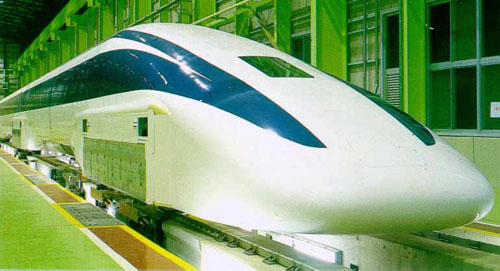




|
|
| [Prev| Next| Skip Next| Random| Next 5| List Sites] |
